|
JEFF DALY'S SYSTEM
LOUDSPEAKERS
ELECTRONICS
SOURCE
CABLES
ACCESSORIES
|
Positive Feedback
ISSUE
63
september/october 2012
tempo electric
Big Twist Aurum Ag Interconnects
as reviewed by Jeff Daly
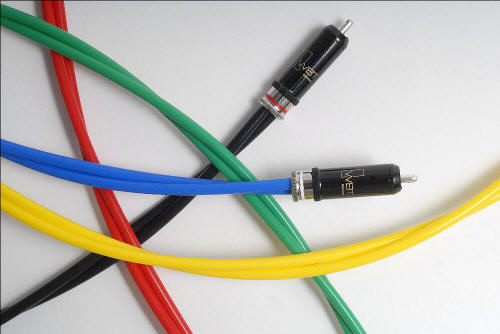
All images courtesy of Tempo Electric Custom Audio, Jeff Daly, and Joseph Levy
Joseph Levy is the owner of Tempo Electric Custom Audio, and just so you know, Joseph has particularly good taste in audio. Besides being an artist and record collector, Joseph is more than a little fond of the audio electronic designs of Dr. Arthur Z. Loesch, who sadly passed away on April 5th of this year [2012] after a long battle with cancer.
Dr. Loesch was a scientist, university professor, and an audio enthusiast with a penchant for designing high-performance audio electronics. Dr. Loesch was a member of the Catskill and Adirondack Audio Society in Albany, New York, and he was a primary source and consultant for a two-volume book on Western Electric, Western Electric Sound, which was published by Japan's Stereo Sound magazine.
Joseph founded Tempo Electric Custom Audio in 1999 specifically to produce definitive versions of Dr. Loesch's audio designs, which have now been featured in Stereophile, Bound-for-Sound, and Sound Practices.
The two of them working closely together to make some truly impressive electronics, like the Arthur Loesch Model 301 Mono Amplifier and the Arthur Loesch Model 302 Mono Amplifier, utilizing Western Electric 300B or Type 50 vacuum tubes (below). It's enough to make me drool on my keyboard. Aren't they beauties!
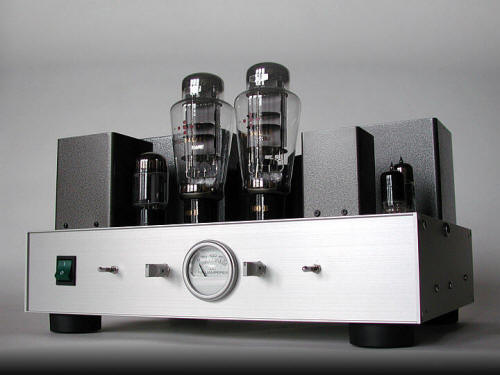
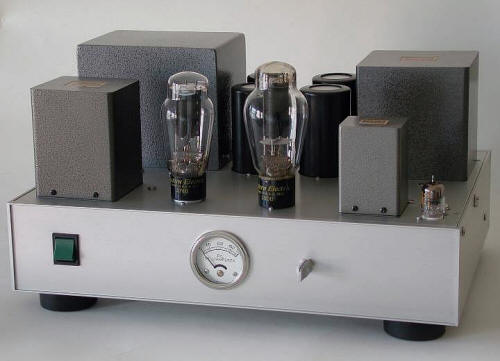
Joseph and Dr. Loesch also teamed to produce the Arthur Loesch 1.1 Control Preamplifier with Phono Stage (below) which Art Dudley awarded a 'Class A' rating in Stereophile magazine.

The phono stage is available as a stand-alone item in the Arthur Loesch 1.1 Phono Stage.
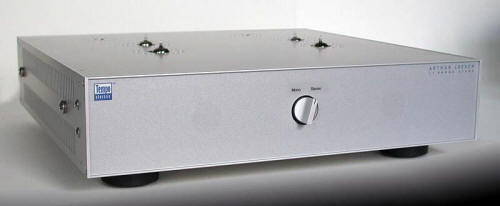
Remember when I mentioned that Joseph is a record collector? One thing that record collectors need is a way to adjust phono equalization for the dozens of equalization curves that were used on records before the RIAA curve was adopted in 1954, so Joseph and Dr. Loesch developed the Arthur Loesch Universal EQ Mono Preamplifier for vintage record enthusiasts like themselves.
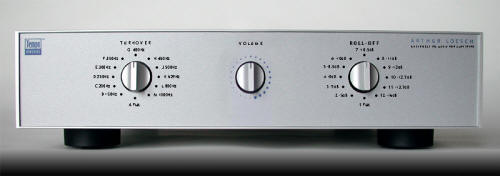
I don't know about you, but the suite of electronics that Joseph and Dr. Loesch have designed really impresses me, and I think they represent a truly significant accomplishment and contribution to the audio arts.
The the 301 & 302 Mono Amplifiers are no longer in production, but Universal EQ Mono Preamplifier and the 1.1 Preamplifier and 1.1 Phono Stage remain available. Also in current production are the Big Twist interconnects, speaker cables, and power cords.
The Big Twist Aurum Ag Interconnects
I was particularly intrigued by what I had read about the Big Twist Aurum Ag Interconnects on Joseph's website. In fact I was so intrigued by their description that I asked Joseph if it would be ok if I wrote about them for you here at Positive Feedback Online. Joseph graciously agreed to lend me a pair to listen to for the article.
There's quite an interesting story related to the Aurum Ag interconnects, and that has to do with gold and silver. Eagle-eye readers will have noted that aurum is the Latin word for gold, and that Ag is the periodic table symbol for silver (and which is short for argentum, the Latin word for silver).
Here's what Joseph says about the genesis of the Big Twist Aurum Ag Interconnects on the Tempo Electric Custom Audio website:
"At the request of a client in Europe, we recently fabricated a pair of 1 meter, hybrid interconnects in which the positive conductor was made from extra soft 24K gold wire and the return (minus) conductor from extra soft silver. Since we knew that gold was not as good a conductor as silver (it's measurably true) and had heard that it tended to make the music sound a bit slower, we weren't expecting much from this experiment. However, we were truly surprised to hear noticeably less grain through the gold hybrid pair. The sound was clearly more fluid and analog sounding, in a way that only live music can be. Although they seemed to shift the spectrum down a notch, the highs did not really sufferin fact, they sounded even smoothernor did the speed of the music. The benefits, at least on LPs, were all positive. Results varied from record to record and your equipment may tell a different story, but now we use them as our personal front-end reference! "
Those of you who have been reading my articles for a while probably predicted that when Joseph mentioned that the Aurum Ag (i.e. gold/silver) combination interconnects provided "noticeably less grain" and "was clearly more fluid and analog sounding, in a way that only live music can be" that my ears perked right up, as it seems that I'm always looking for more of those qualities in my own little audio world.
Ok, so gold is 60 times more expensive than silver, so you're probably cringing and thinking that the price for the Aurum Ag interconnects is going to be out of this world, but you can relax, as the Aurum Ag interconnects start at $370 USD for a half meter, and are $556 USD for a 1-meter pair of the 28 gauge phono interconnects, which I think is a pretty friendly price considering they're created from such exalted materials.
When you order a pair of the Aurum Ag interconnects Joseph allows you to choose which connectors you want to use, and which color of the casing you want, which I think is a nice customizing touch. The pricing varies depending on the gauge & length of the gold conductor you order, and the brand of RCA you choose.
If you want to roll up your sleeves and make your own interconnects, Joseph also provides detailed instructions and access to materials as well, so you can build pretty much any kind of design variation you want. I think that's really cool, and having enjoyed making my own interconnects and speaker cables in the past, I think I feel a new interconnect project coming on one of these days!
Joseph found during his research that different gauges silver and gold wires work best in different applications. For example, for silver, Joseph thought 30 gauge works best for phono interconnects, 24 gauge for line level interconnects, and 16 gauge (or heavier) for speaker cables. For gold, Joseph uses 28 gauge in the phono interconnects and 24 gauge for line level interconnects.
For the Big Twist Aurum Ag Interconnects that are in for review, the positive conductor that connects to the center pin of the of the RCA connector is an extra soft 28 gauge (0.32mm diameter) 24 carat gold wire, with the return conductor being 4N (99.99% pure) 28 gauge, extra soft pure silver wire.
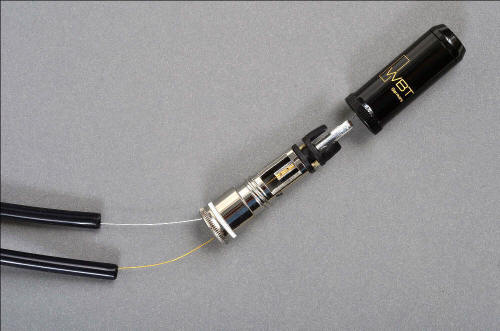
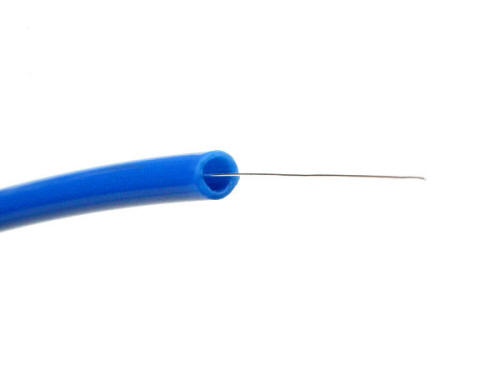
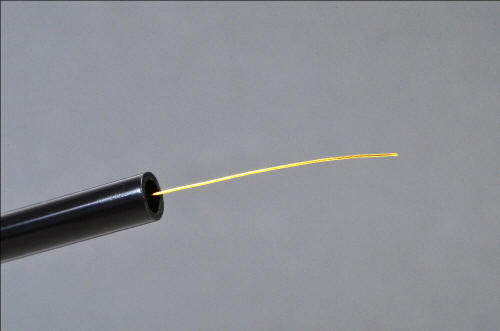
Joseph says there's been quite a bit of debate in the cable community about which jacketing to use on cables. In tests Joseph has compared nude designs (no jacketing), Teflon jacketing of various diameters, and cotton jacketing. What he found out that was no jacketing sounded best, cotton was next best, and a 28 gauge Teflon jacket was the worst sounding. The sound quality was related to the dielectric constant of the jacketing used, and Joseph found that as the dielectric constant decreased the sound became much more open and the test system projected a much larger sound stage. As you probably have surmised, no jacketing (air) had the lowest dialectic constant, cotton was the next lowest, and Teflon was the highest.
Joseph liked the way the cotton jacketing sounded, but he didn't like the way it allowed electrical noise into the signal conductors (as dielectric constant goes down the noise can go up if there are noise sources close by). You can twist the conductors to help reduce noise, but with cotton noise can still become an issue. Joseph came up with a way to 'trick' the conductors into thinking they were surrounded by air while still maintaining the insulating properties of the Teflon. The answer was using oversize Teflon tubing to make the conductors think they were surrounded by air (which is actually the case when there's lots of space in the big Teflon tube), and then twist them to further increase noise rejection. (I'm guessing that's where the name "Big Twist" comes from. Big tubing. Twisted conductors. Big Twist. Get it?)
Joseph found a sweet spot with oversize 8 gauge Teflon tubing, which gave lots of air space around the conductor, and closely matched performance of cotton jacketing in openness and sound stage size, while still retaining the insulating properties Teflon.
The only way you can make cables highly resistant to noise contamination is to use copper braid shielding with a shield to ground connection. The only problem is that shielding tends to decrease sound quality by reducing air and transparency and restrict frequencies above 10kHz. At this point Joseph feels that the losses incurred by using shielding don't make up for the benefits, so the Big Twist cables will remain unshielded unless Joseph can find a way to add shielding that has no sonic downside.
Joseph really likes the WBT-0102Ag NextGen locking RCA plugs. The WBT RCAs use pure silver conductors that are platinum-plated to reduce oxidation. They utilize a platinum-plated brass body with a central contact assembly made from high-tech polymers: Ultramid for the central contact and Duneon for the negative contact. The barrel is fabricated from brass and coated with black piano lacquer. WBT says the transmission bandwidth extends to 1 GHz, and it has 75-Ohm impedance that works great for both digital and analog.
Ok, so there you have it: the Aurum Ag Big Twist interconnects are a purist design incorporating 28 gauge 24-Carat gold signal wire and 4N 30 gauge silver wire for the return. They're wrapped in 8 gauge Teflon tubing that is intended to mimic an air dielectric, and then they're twisted to aid with noise rejection. They're terminated with ultra-quality WBT RCAs. The 1-meter long Aurum AG Big Twist 28 gauge interconnects terminated with WBT-0102Ag NextGen locking RCA plugs that I have in for review sell for $656 USD. Not bad when you consider that the WBT RCAs alone retail for $348 USD for a set of 4.
Preliminaries
For this review I used my Review System 1 which consists of an EMT TSD-15 phono cartridge mounted on a VPI Classic turntable, a New Valve Order SPA-II phono stage, a Leben RS-100 line preamplifier, Sophia Electric 91-01 or Fi 300B mono amplifiers, and Tannoy Westminster Royal SE loudspeakers. During the review period the Leben preamp, 300B mono amps, and Westminster loudspeakers were replaced with the Tannoy Kingdom Royal loudspeakers and the ASR Audiosysteme Emitter II Exclusive Version Blue four-chassis integrated amplifier that are in for review. Interconnects were largely Sablon Audio Panatela or Acoustic Revive, speaker cables were Auditorium 23, and power cords were a mixture of Sablon Audio and Acoustic Revive. I also use quite a number of the very effective Acoustic Revive accessories to optimize performance of the system in my primary listening room.
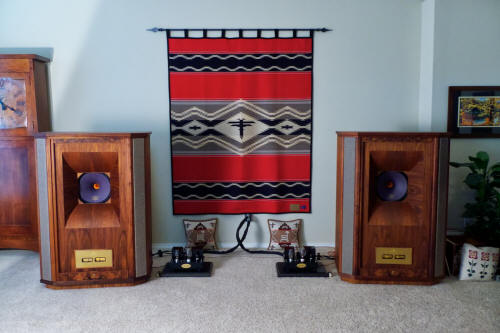
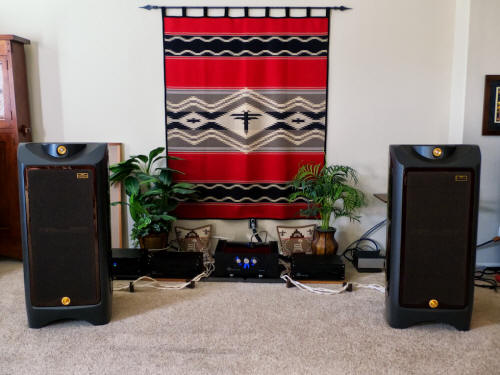
The interconnects that I used for comparators with the Big Twist Aurum Ag Interconnects were two of my favorites:
1) The Sablon Audio Panatela ($850 USD for a 1-meter pair), which like the Big Twist is a purist design. The Panatela uses silver conductors for signal & return, cotton jacketing, no shielding is used, and they are terminated with Xhadow RCA connectors that use set-screws to connect the conductors to the contacts so there are no solder joints. I heard some noise reducing crystals jiggling around in the 2012 version of the Panatela interconnects RCAs. I'm guessing quartz or Tourmaline. Overall, this is the best interconnect I have used to date, when considering both its sonic & musical capabilities, except when there is high RFI present, when it can't be used due to the design being susceptible to noise.
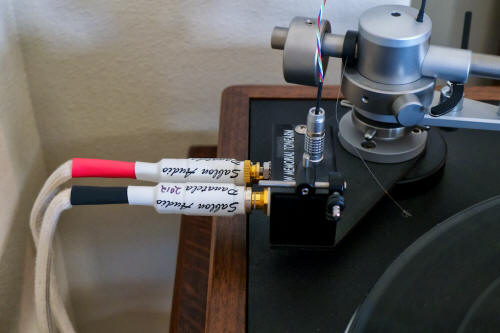
2) The Acoustic Revive Single Core ($1275 USD for a 1-meter pair). The Single Core is an entirely different animal from either the Big Twist or Panatela, but like the Big Twist or Panatela they are handcrafted labors of love. The conductors are an Ohno, greater than 8-Nines, single-crystal copper wire that has been annealed to increase its pliability and conductivity. The conductors are covered with a natural silk dielectric, which is then covered with Teflon coated flexible copper tubing that provides 100% shielding from RFI. The entire cable assembly is covered with mesh polyurethane tubing containing embedded carbon particles to provide additional shielding and vibration isolation. They are terminated with solder-less connectors. In noisy RFI conditions the shielded Single Core is completely quiet, and the best interconnect I have tried under adverse RFI conditions.
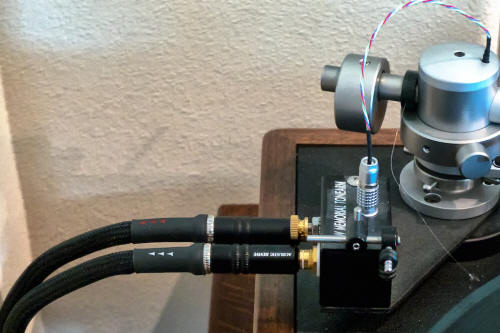
I recently purchased one of Alan Kafton's Audiodharma Anniversary Edition Cable Cooker devices to condition the cables I review. That way I know all the cables will be thoroughly broken in and at their optimum level of performance. It makes a significant difference in cable performance to condition your cables with an Audiodharma, and as a reviewer I felt it was an absolute necessity to make sure every cable is operating at its top level of performance to make sure you get an accurate and reliable review of the ultimate performance you can expect. I also think cables need occasional conditioning to keep cables at their best. Joseph told me he didn't think the Aurum Ag interconnects would benefit from conditioning, but I decided to do a full conditioning anyway, so there would be an equal playing field with the Panatela interconnects which had received similar conditioning on a Audiodharma by their manufacturer. The Acoustic Revive Solid Core interconnects were also conditioned in similar fashion on the Audiodharma to ensure a level playing field.
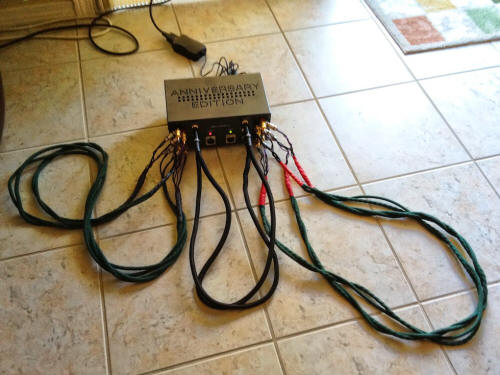
Reviewing interconnects is tedious, time consuming, and a lot of work. The routine goes something like this: Listen to an album, take notes, and then shut the system down and replace the first set of interconnects with the second pair of interconnects to be listened to. Then listen to the album again with the second pair of interconnects, take notes, and then shut the system down, and replace the second set of interconnects with the third set of interconnects to be listened to. Listen to the album again, take notes, and then change albums to see how performance varies over different styles of music (jazz, classical, vocals, folk, rock, popular, etc.). You have to repeat the process over again & again with each different style of music to get a handle on how the interconnects being auditioned perform in a variety of settings.
Not too many things will bring me out of hiding to go through that process anymore, but I was really intrigued by the Tempo Electric Big Twist Aurum Ag Interconnects with their gold and silver conductors, so I wanted to give them a go. I listened to a lot of music just for fun to get a general feel for the Aurum Ag's performance, and then settled in with some specific albums for comparative purposes: the Analogue Productions 45 RPM reissue of Jazz Impressions of Black Orpheus by The Vince Guaraldi Trio; the Analogue Productions 45 RPM reissue of Getz/Gilberto by Stan Getz and Joao Gilberto; the Speakers Corner reissue of the Decca recording of Tchaikovsky's The Sleeping Beauty ballet with Ernest Ansermet conducting the Suisse Romande Orchestra; The Rolling Stones Hot Rocks 1964-1971; my Analogue Productions test pressing of Doc & Merle Watson, Sittin' Here Pickin' the Blues; the Fairytales album by Radka Toneff with pianist Steve Dobrogosz; and finally the Readers Digest box set of Bing Crosby music called Bing Sings.
Listening Impressions
First of all, it's obvious to me that after listening to the Tempo Electric Aurum Ag Big Twist (hereafter "the Aurum") in my Hi-Fi on a lot of different music that it is truly a world class interconnect, both musically and sonically. In very general descriptive terms, the Aurum provided a big, rich, smooth, colorful, and life-like presentation of the music that was infused with natural warmth and emotion.
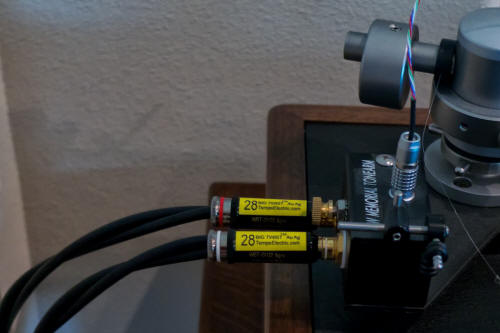
The Music
Ok, lets first talk about some examples of how well the Aurum plays music, or more particularly, those recorded elements that make up the music like the timbre, the melodies, the harmonies, the beat, the tempo, and the dynamics. From a music lovers' standpoint, the realistic portrayal of timbre, melodies, harmonies, beat, tempo, and dynamics are what's most important about what's on a recording, and as such the fabric that makes up the music is given a lot of weight in overall performance.
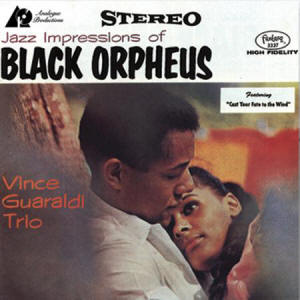
From a musical perspective, the Aurum positively growled with natural timbre on Colin's double bass at the start of Cast Your Fate to the Wind from the Analogue Productions 45 RPM reissue album of Jazz Impressions of Black Orpheus by The Vince Guaraldi Trio. The Aurum projected a big, rich, expansive, colorful, and beautiful presentation of the music that bettered both my reference interconnects on Jazz Impressions of Black Orpheus in conveying the illusion that I was sitting in a candlelit jazz club listening to an intimate live performance, with a glass of Grand Cru in my hand, next to a beautiful woman. The rich timbral presentation of the Aurum was really enchanting, and I liked it a lot.
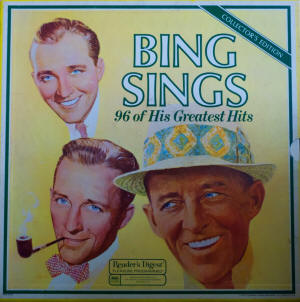
One of the more important tests for interconnects is how well they do with real world recordings, those recordings of great music but perhaps dodgy sonics. Can your interconnects make sense out of the music and present it in entirely enjoyable fashion regardless of the recording quality? During the review period my friend Cindy found a nice Bing Crosby box set called Bing Sings in a local classified and bought it for me knowing I'm a big Bing Crosby fan (Thanks Cindy!). This is a box set of fantastic music, but the sonics can be rough around the edges at times. The Aurum was the best performer of the three interconnects on the Bing Crosby box set, Bing Sings, getting the most music out of those LP grooves. Vocals were rich and emotive, strings and brass were timbrally realistic, and the forward momentum of the music came through in spades. The Aurum did the best job of getting around the recordings' sonic rough spots and getting the music across, which it did brilliantly. The Aurum just got out of the way and let me relax into the music. Bravo!
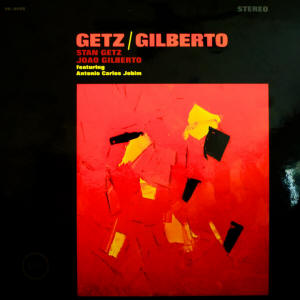
I've always enjoyed the Getz/Gilberto album of Brazilian-style jazz with Stan Getz, Joao & Astrud Gilberto, and Antonio Carlos Jobim. I mean, who doesn't love the song The Girl From Ipanema? I'm not the only one who likes the Getz/Gilberto album either, as in 1965 it won Grammy Awards in the categories of Best Album of the Year, Best Jazz Instrumental Album - Individual or Group, and Best Engineered Album, Non-Classical. That's impressive! The new Analogue Productions 45 RPM version of Getz/Gilberto is what I listened to for the review, and it's really a nice version of this classic album.
Joćo and Astrud Gilberto both sing on the opening song The Girl From Ipanema, so it's a nice opportunity to hear how well the Aurum does on vocals. Joćo's vocals are tonally rich, and you can hear Milton Banana working the cymbals in the back of the soundstage. Astrud's vocal comes in on the left channel at the front of the stage, with that wispy, dreamy quality her voice so easily conveys. The Aurum really presents the vocals in rich, warm, human, and expressive way. There is a slight sibilance on the vocals, but in a way that's consonant with life, and not in any bright or distracting way.
The Aurum does really well as presenting the music as an organic whole, superbly conveying the musical content in recordings like the timbre of voices & instruments, with deep tone colors and rich textures; and melodies, harmonies, and rhythmic content that is immensely satisfying and engaging. With the Aurum I could easily focus in on individual contributions as well. For example, when Astrud finishes her first vocal part on The Girl From Ipanema, Stan Getz comes in on tenor saxophone playing the melody line. The way the Aurum presents the timbre of Getz's tenor sax is right on, and the tone is burnished and gorgeously rich. Same with Jobim's piano: it is back in the stage a bit in the left channel (along with Gilberto's rhythm guitar playing), and Jobim's playing a little harmony into the music, then he takes a run at the melody line for a bit until Astrud comes back in with her vocals, and then everybody starts backing her and playing the instrumental parts out as they finish off the song.

On rock & roll the Aurum suffers a little in respect to the Single Core (which is the beat-master of this group). For example, with the Aurum the beat doesn't really drive the music forward on I Can't Get No Satisfaction like I want it to for rock, and the Aurum doesn't really catch the angst that the music is supposed to express to the extant I would like. It sounds beautiful and dreamy, which doesn't seem quite right for this music. The guitars don't sound quite aggressive enough, not growling and snarling like I'd like. I didn't feel the urge to get up and jump around and dance or play air guitar. The Aurum sounds spacious and rich and throws a huge soundstage on Time Is On My Side. The Aurum gives you lots of soundstage depth and layering, with really solid imaging and good tonal color, but clearly the Single Core plays rock music better, and is the timekeeper of this group of interconnects, excelling at beat, melody lines, and the like.
The Panatela does a pretty good job on rock & roll, but it can't match the Single Core either, which is the King of Rock & Roll. The Single Core kicks ass on The Rolling Stones, giving this classic rock & roll plenty of swagger and attitude, with guitars cutting through the music to let the world know, "Don't fuck with me!" The sound quality is really good too, with lots of space, great dynamics, superb imaging, and the beat surges forward giving a solid foundation to the music. With the Single Core in the system you'll want flip the authorities the bird and sing along with abandon, while you dance around the listening room struttin' your stuff like Jagger himself. The guitar lead-in on I Can't Get No Satisfaction made me jump up off the listening seat and grab my guitar to play along screaming "I can't get no satisfaction!" Woo-hoo! It was surprisingly satisfying. Ahem.
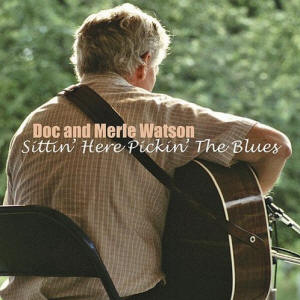
On my Analogue Productions test pressing of Doc & Merle Watson's Sittin' Here Pickin' the Blues, the Aurum handled the vocals better than the Panatela, for example, with only a little stress showing on Doc's vocal peaks. The Single Core handled Doc's vocal dynamic peaks better than either the Panatela or Aurum, with less strain on peaks. The Panatela sounded a little peaky on Doc's vocals, with the sound breaking up a bit. The vocal harmonies through the Aurum are a thing of beauty though, and harmonies in general excel with the Aurum. The Aurum brings more space to the presentation, and a little extra warmth. While the Panatela sounds very good on Pickin' the Blues, it is bested by the Aurum overall. The Aurum doesn't handle the presentation of tempos quite as well as the Panatela, and the melodies aren't quite as engaging. The Panatela is livelier sounding than the Aurum, and with more sparkle. Sometimes this benefits the Panatela, other times it is a bit too much.
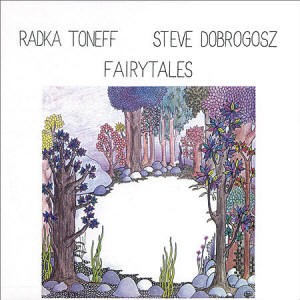
I really like the Radka Toneff album Fairytales, with pianist Steve Dobrogosz. The Aurum sounds great on Radka's vocals, but can't quite match the Single Core for vocals. Like the Panatela, the Aurum resolves a lot of information, and sometimes that works better than others (like with classical), but at other times it accentuates issues with recordings, surface noise of records, and the like. The Single Core sounds simply spectacular on Radka's vocals, being dynamic, rich, expressive, and engaging musically. Piano tone is beautiful, great timbre and tone color. The Single Core really nails the feel of the music, of the three interconnects it seems to be able to get emotional impact of the music across. The Panatela was similar to the Aurum (very beautiful) on Fairytales, but more resolving, and with more sparkle (and more surface noise). Surface noise was greatest on the Panatela, then the Aurum, and lastly the Single Core where you don't really notice it.
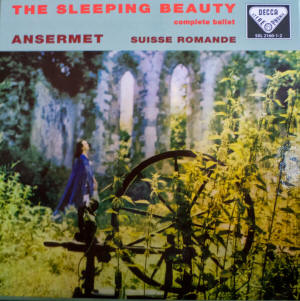
The Panatela really shines on The Sleeping Beauty, where its extra resolution and transparency bring the orchestra to shimmering life, unraveling the complexity of the performance so you can really enjoy it. The detail is presented in a natural fashion, so timbrally everything sounds realistic, and it's easy to pick out the contribution of different instruments, making the music exciting and fun to listen to. On The Sleeping Beauty the Panatela gives rich string tone, expressive musicality, and sparkling highs. The Aurum sounded very good on The Sleeping Beauty as well. The Aurum was more resolving and had greater transparency than the Single Core, and did a better job of separating out the instruments into their individual images across the landscape of the soundstage. Tonally and texturally the Aurum isn't quite the match of the Panatela on complex classical music, but it comes close and makes for a compellingly musical and beautiful performance that was very impressive. The Single Core sounds expressive but a little muffled on The Sleeping Beauty, and can get a bit brash at times when the big dynamic swings come in.
To summarize from a musical standpoint, each of these three interconnects were superb. They have good musical flow in the way they portray the melody, rhythm, beat, harmonies, and tempo, resulting in an overall presentation of the music that I found to be really engaging. While all these interconnects are very satisfying musically, and I could easily live with any one of them (and do), they do have relative strengths among themselves.
For example, on small group jazz the Aurum generally excels over the Panatela and the Single Core (in that order). The way the Aurum portrays the timbre, melody, rhythm, beat, harmonies, and tempo, with a little more liquidity & sense of relaxation favors the overall presentation of jazz.
For most classical music (e.g. or more complex music) the Panatela excels, followed closely by the Aurum, and a little more distantly by the Single Core. The Panatela's extra resolution and sparkle serves it well with classical music, where it unravels the complexity of the orchestra by giving lots of structure by highlighting the distinct timbres of individual instruments. That combined with the snappier portrayals of melody, rhythm, beat, harmonies, and tempo make for an exciting and engrossing portrayal of the music with the Panatela.
On rock & roll (and vocals generally) the Single Core is more capable than the Panatela and Aurum. The Single Core portrays the beat in riveting fashion, with melody, rhythm, harmonies, and tempo coming to life in the time domain in gripping fashion. When it came to portraying the time elements of recordings the Single Core was hard to beat (accidental pun). The musical engagement factor was very high on the Single Core.
All of these cables have great ability to be engaging musically, with the selection of the music being the main factor on which one will come out on top. On jazz the Aurum seems better, on rock the Single Core, on Classical the Panatela.
From timbral perspective, on most music the Single Core is probably the closest to what you hear in life in both tone & texture (except for with classical music, where it doesn't seem to be able to unravel the complexity of timbral structure contributed by the individual instruments as well as I'd like it to). The Panatela portrays timbre nicely on all music, but is a little more detailed texturally than life is, and has a little more magic "sparkle" to its tone color than reality does. This extra resolution and sparkle serves the Panatela well with classical music, where it unravels the complexity of the orchestra superbly, giving lots of structure by highlighting the distinct timbres of individual instruments to make for an exciting and engrossing portrayal of the music. The Aurum also portrays timbres beautifully with lots of structure, and like the Panatela, it is slightly impressionistic, but by being slightly richer and more 'golden' than life, resulting in a slight romanticizing of the timbres through smoothing them and giving a deeper saturation of the tone color, which is not necessarily a bad thing in most Hi-Fi.
The Sonics
Now let's talk about how well the Aurum fares on classical audiophile-style sonics, where the reproduction of recording artifacts like transparency, soundstaging, imaging, sense of recorded space, are given a lot of weight in overall performance. When the sonics are done really well it lends a sense of awe and wonderment when listening to a recording, making experiencing the music even more engrossing than it would be in their absence.
The Panatela resolves the most detail and is the most transparent, followed closely by the Aurum, with the Single Core lagging a bit behind (no doubt due to the use of shielding in its design). This high level of detail resolution and transparency served the Panatela particularly well on classical music like the Speakers Corner box-set reissue of the Decca recording of Tchaikovsky's The Sleeping Beauty ballet, with Ernest Ansermet conducting the Suisse Romande Orchestra. From an LP surface noise perspective means that the Panatela highlights surface noise the most, the Aurum smooth's the surface noise out a bit, and surface noise pretty much disappears with the Single Core unless it's a major glitch.
The Aurum hands down produces the largest sense of space of these three interconnects. With Joćo and Astrud's vocals on Getz/Gilberto the Aurum gives a huge sense of recorded space. That's not just limited to Joćo and Astrud's vocals either, as the Aurum did that with all the instruments on the album too, presenting a big cushion of air around them. The Aurum lights up the entire recorded acoustic with a sense of air & space, almost in the same way that adding a sub-woofer adds a bigger sense of space, and in this regard neither the Single Core nor Panatela can match its performance. The Aurum was notable for the huge amount of the recorded sense of space it projected, where it easily bested the comparator interconnects. I suspect the Aurum's prowess for recorded space is due to the influence of the gold conductor, which seems to have much the same sort of effect on increasing the sense of recorded space as adding a sub-woofer does (albeit without adding the additional bass extension). I found this to be one of the most intriguing aspects of the Aurum in day-to-day use. The Panatela was next for the amount of space produced, followed by the Single Core.
Soundstaging ability is similar between the Aurum and the Panatela (both are capable of throwing huge soundstages), however the Aurum is more smooth and continuous in the way the depth dimension of the soundstage is portrayed, while the Panatela gives a more distinct impression of the soundstage going back in layers. The soundstaging ability of the Single Core is good too, but because it doesn't have a dominant sense of space like the Panatela & Aurum do, it provides more of a "they are here" type of presentation, placing the musicians in the listening room, rather than a "you are there" type of presentation, that transports you to the recording venue. For soundstaging, I think the Aurum comes in first for its huge portrayal of space and its continuous presentation of the dimension of depth.
With the Aurum, images have a more flesh & blood sense of body and realistic presence than with the Single Core and Panatela, which serves it really well on jazz and blues, for example. The Single Core has a lot of image presence & solidity, but with a more diffuse outline, compared to the Aurum, which serves rock & roll and vocals very well. The Panatela has very distinct image outlines, but the images don't have as much of a flesh & blood body to them, and as a result they are more translucent and holographic, which can be very enchanting on classical music.
From the perspective of transporting you to the recording venue, or the opposite case, of putting the performers in your listening room, here's how these three super-interconnects presentation differs: The Panatela has more of a 'you are there' presentation, than a 'they are here' presentation, mostly because its greater transparency and higher level of detail recovery make the soundspace of the recording venue more apparent than the acoustic of the listening room, compared to the other two. The Single Core has more of a 'they are here' presentation that puts the images more solidly in the listening room, for exactly the opposite reason, as there was less detail recovery and less of a sense of space, which let the listening room acoustic be more dominant.
The Aurum is the one that's different among these three interconnects, and it pulls a sort of magician's hat trick in that it does both the 'they are here' and the 'you are there' at the same time. "What?" you say! Yeah, the Aurum is the champ in capturing the sense of space of these three interconnects, and it fills the listening room with a huge rich sense of acoustic & space that even the Panatela can't quite match. The interesting thing about the way the Aurum renders space is that it is so naturally presented and it couples so well with the room's natural acoustic it feels like it becomes part of your room. That combined with the Aurum's more natural presentation of a flesh & blood body in its presentation of images, and having less micro-detail than the Panatelas, puts the 'there' 'here' if you get my drift. The Aurum's was a pretty cool presentation in this regard, and the other two just can't quite match it.
All Together
When I consider Hi-Fi equipment performance I like to consider both how well the component under consideration performs sonically related to the reproduction of recording artifacts like transparency, soundstaging, imaging, sense of recorded space, and the like; but also how well it fares on portraying the musical content of recordings like realistic timbre, the melodies, the harmonies, the beat, the tempo, and the dynamics. Now it's time to consider how the sonic & musical abilities these interconnects add up as a whole to deliver a satisfying listening experience from the recording.
First of all, each of these three interconnects were engaging musically, timbrally realistic, smooth, had great sonics, and had no major flaws that distracted me from enjoying the musicthat's a big complement to all three interconnects.
There are a number of key words that come to mind when I think about the Aurum: Big, rich, natural, warm, colorful, musical, life-like, and spacious. The Aurum has a 'there is here' style of presentation, as discussed above. I think the Aurum is perfect for lean-to-neutral systems that need a touch more of humanity, color, and life in their presentations, or for anyone who craves more of those qualities in their listening experience. I also think the Aurum is perfect for those who listen to a wide spectrum of music of varying recording quality, and I think it will extract the most music from the most records without compromised sonics becoming a distraction. On a sonics-musicality spectrum, the sonics are very good, but the overall presentation tips over to the musicality side of the spectrum. The Aurum is a great sounding pair of interconnects with exceptional musicality, and I think music lovers will find a lot to like about the Aurum with its nice balance of sonics & musicality.
When I think about the Panatela there are also a number of key words that come to mine: detailed, transparent, nuanced, delicate, neutral, and sophisticated. The detail and transparency of the Panatela was presented in a natural fashion, so timbrally everything sounds reasonable, and it's easy to pick out the contribution of different instruments, making music exciting and fun to listen to. The Panatela has a 'you are there' style of presentation. The Panatela is a great choice for neutral-to-warm systems needing a little more sparkle, charm, and sense of wonderment to their overall presentation of the music. On a sonics-musicality spectrum, the sonics of the Panatela are extremely good, with the overall presentation tipping over slightly into the audiophile-sonics side of the spectrum. The Panatela is an impressive sounding pair of interconnects with great musicality, and I think audiophiles will find a lot to love about the Panatela's sonics, and they will be impressed that it delivers such a large measure of musicality along with it. The Panatela has a really nice balance of sonics & musicality.
When I think about the Single Core there are a number of key phrases that come to mind: "beat-champs", "jump up and dance", "ultra quiet", "lively & dynamic", and "exciting". The Single Core interconnects have a 'they are here' style of presentation and always get the musical message across, and they're remarkably good with vocals. The Single Core interconnects are a great choice for systems that need the beat, melody, and tempo to come alive, or for systems that need to be delivered from noisy RFI. On a sonics-musicality spectrum, the sonics of the Single Core are extremely good, but perhaps not as good overall as the Aurum or Panatela. The overall presentation tips to the music lovers' side of the spectrum, and the Single Core is remarkable in its ability to get the emotive qualities of music across. Those of you who really love rock & roll will go nuts over the Single Core interconnects, nobody does it better. The Single Core has a nice balance of sonics & musicality that will really please those who live in a noisy RFI environment.
Practical Considerations
From a quality of construction standpoint the Tempo Electric Aurum Ag Big Twist, the Sablon Audio Panatela, and the Acoustic Revive Single Core interconnects all exude an extremely high level of quality and are made from the finest materials available. They are dead even in regards to quality of construction, even though the materials used vary quite widely between them. Gold, silver, or copper, it's your choice. Shielding or no shielding, it's your choice. Teflon, silk, or cotton tubing, it's your choice. They're all brilliant designs, albeit for different reasons, and you can't go wrong by choosing any of them.
From an operational standpoint I didn't like the locking RCA connectors of the Acoustic Revive Single Core and Tempo Electric Big Twist Aurum Ag Interconnects as well as I did the snug press-on fit of the Xhadow RCA connectors used on the Sablon Audio Panatela interconnects, as locking RCAs are more of a nuisance to take on and off while reviewing. For most end users that will not be a issue though, as once you put your new interconnects on they'll likely stay put for quite a while. One thing I didn't particularly like about the oversize Xhadow RCA connectors was that for some components where their RCA connectors are spaced very closely or located in a confined space the oversize Xhadow RCAs can be too big to fit.
Each of these interconnects will complement some systems more than others. If your system is neutral to lean sounding and you're looking for a warmer, richer, and more colorful presentation I think the Tempo Electric Aurum Ag Big Twist would be your best bet of these three interconnects. If your system is warm to neutral sounding I think the Sablon Audio Panatela will be a revelation for you in how good it sounds with its extra resolution, transparency, and delicious tone color. If you live in an area with high RFI and you need something that is superb sounding across the board, but is also very quiet, the Acoustic Revive Single Core should be on your short list.
All of these interconnects are well balanced from a musical perspective, and they can play any kind of musical genre with aplomb. However, I think that if you're the kind of listener who almost exclusively listens to one kind of music, say jazz, or classical, or rock & roll, one of these interconnects will be a better choice for you than the others, as each of these interconnects has characteristics that really bring to life particular styles of music, in a way that makes them excel above their peers. If you listen to jazz predominantly the Aurum Ag Big Twist is hard to beat. If you listen to classical predominantly the Sablon Audio Panatela is fantastic. If rock & roll is what you listen to the most the Acoustic Revive Single Core is unparalleled.
Personally, I think you would find it very rewarding to have one of each of these three interconnects and go through the same process I did. It will be an eye-opener for you, and it will be a lot of fun as well. Personally I think everyone would benefit having one of each of these interconnects in the cable library.
Summary & Conclusions
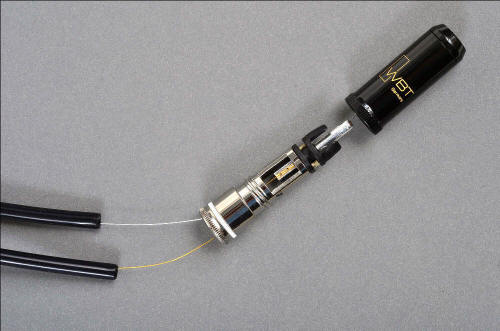
Let me get straight to the point: The beautifully hand-crafted Aurum Ag Big Twist is a world class interconnect that performs sonically and musically at that same lofty performance levels as heavy-weights like the Sablon Audio Panatela (which costs $850 for a 1-meter pair) and the Acoustic Revive Single Core (which costs for $1275 for a 1-meter pair), making the Aurum a particularly good value at $656 for a 1-meter pair of interconnects.
The Aurum Ag Big Twist will be a great choice for those with systems that are neutral to a lean sounding, or for anyone wanting to inject a little extra musicality into their Hi-Fi. The Aurum's rich, spacious, liquid, smooth, and colorful presentation is immensely likable and musical. The Aurum will infuse a system with color and life, giving an injection of musicality that will reward you with hours of beautiful music listening experiences.
The Aurum performs extremely well across all musical genres, and is particularly mesmerizing on jazz. One thing to keep in mind is how well the Aurum performs on real-world recordings like the Bing Crosby box set I mentioned early. If you like to listen to a wide variety of music that is not always well recorded, the Aurum will open up the spectrum of what you can enjoy quite a lot for you, and for music lovers that means a lot.
I highly recommend the Tempo Audio Aurum Ag Big Twist interconnect for their impressive sonics and musicality. I suggest you give them a listen in your system, I think you'll be as impressed with their performance as I was. Jeff Daly
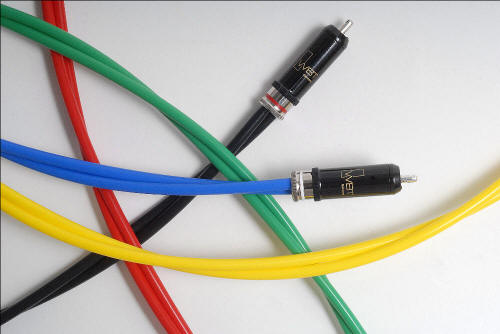
For more information about the Aurum Ag Big Twist interconnect please contact Joseph Levy at the website's eMail link or at (518) 542-7004.
Joseph says the best time to reach him by telephone is 10AM-7PM, US Eastern Time, and "If you reach our voicemail, please leave a message with the best time to return your call."
Joseph says he tries to reply to inquiries within 24 hours.
Tempo Electric Custom Audio
www.tempoelectric.com
